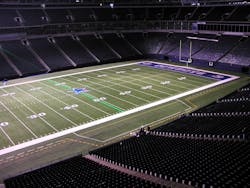Whether mounted in stadium overhead lights, on a guy-wire system high above the field, or in chain-pulley flag sets at the sides of the field, the laser line system developed by First Down Laser Systems (Hempstead, NY) uses patented technology to project a visible green line onto the field of play. Already demonstrated in numerous sporting events, including the June 2013 NCAA Outdoor Track and Field Championships and now scheduled to be tested with the Canadian Football League, the projected line provides players with a visible marker on the field that has been shown to reduce injuries (by players attempting to see the side-line markers) and, in the case of Olympic and other competitive sports events like the long jump and shot put, can actually improve players’ performance as they push to exceed the visible record marked by the laser.
The system design uses two 100 W IPG Photonics (Oxford, MA) green lasers connected to a shielded, 200-μm-core optical fiber located in the tunnel that bring the light to two 30 × 4 × 5.5 in. laser flag sets that project a 4-in.-wide green laser line starting 6 ft out from the housing and extending as far as 53.3 yards—the width of an NFL football field. The system includes a 120 frames/s camera mounted on the projectors and connected to a “helmet directional algorithm” system to shut down the beam if it is close to intersecting a players’ face guard; Honeywell (Lincolnshire, IL) is in the process of making a redundant laser protective helmet visor as well. First Down Laser continues to discuss implementation of the laser line system with NFL officials; the projected leased price of the system is a minor expense, considering that the NFL could gain $300 million in new ad revenues yearly as the system eliminates having to bring out the chains on average of 3 min each game. Contact Alan Amron at [email protected].

Gail Overton | Senior Editor (2004-2020)
Gail has more than 30 years of engineering, marketing, product management, and editorial experience in the photonics and optical communications industry. Before joining the staff at Laser Focus World in 2004, she held many product management and product marketing roles in the fiber-optics industry, most notably at Hughes (El Segundo, CA), GTE Labs (Waltham, MA), Corning (Corning, NY), Photon Kinetics (Beaverton, OR), and Newport Corporation (Irvine, CA). During her marketing career, Gail published articles in WDM Solutions and Sensors magazine and traveled internationally to conduct product and sales training. Gail received her BS degree in physics, with an emphasis in optics, from San Diego State University in San Diego, CA in May 1986.
